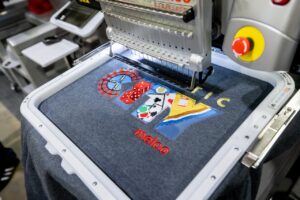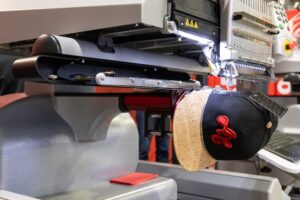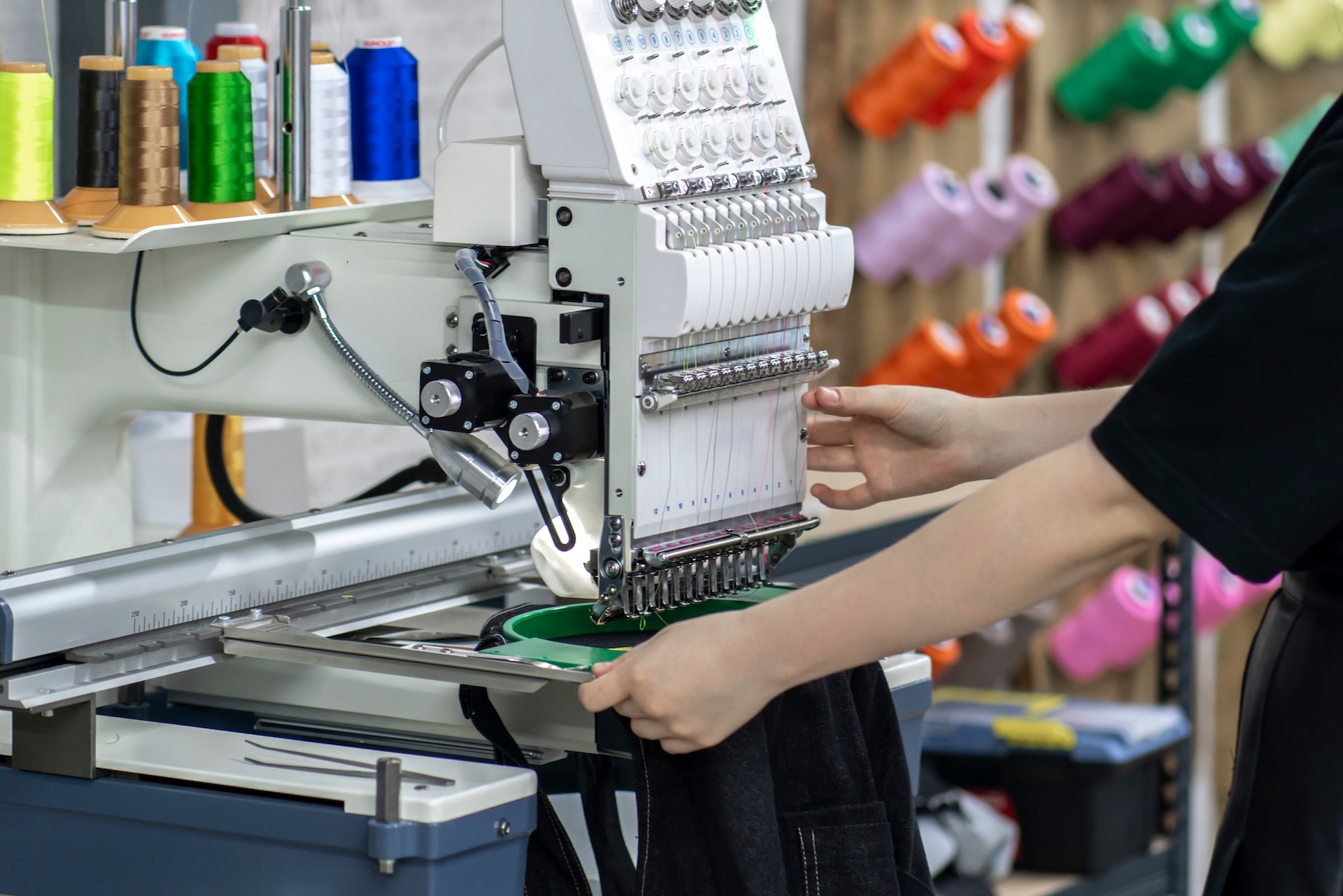A longtime embroiderer, digitizer and educator shares some of the most important lesson he’s learned over the years
Looking back over a career in commercial machine embroidery, digitizing and selling all of the above both online and off, I’m reminded of all mistakes I made that I wish I’d known about when I first started.
As a newcomer to the industry, I was tutored in the running and maintenance of machines by an old-school operator, Elena. Eventually, though, I discovered a derelict digitizing system languishing under its dustcover in a forgotten corner of the office, and my interests and the arc of my career quickly moved beyond the scope of what my compatriots at that first shop could teach me.
For a long time, analyzing the work of the digitizers and stitch-by-stitch punchers who created the designs in our library in combination with a healthy dose of trial and error was the only kind of “education” I ever received. Nonetheless, the lessons I learned in those early days ended up becoming the basis for much of what I teach now. Those core lessons also became critical in not only my digitizing career, but my role at the other companies I’ve worked for since, managing and marketing various products online. And with that, what follows are five things I wish I’d known when I first decided to become an embroiderer and digitizer.
1) With machine embroidery, whatching the stitch-out is vital
This is both literally and figuratively true. To fully understand embroidery and embroidery digitizing, you will find no better teacher than time spent at the machines watching designs run.
When you start, you’ll watch designs from digitizers whose work you know and trust. Eventually, you’ll do the same as you learn and experiment by replicating the techniques of others and then creating techniques of your own. No matter what stage your career career is in, simply watching designs run is critical. Nothing shows you the physical reality of how stitches interact both with each other and the fabric they being applied to; how different stabilizers work; and how the speed and motion of a machine affects the formation, placement and shifting of the stitches like watching actual embroidery happening in real time.
When I started operating 12-head machines, the ones I ran had no thread-break sensors. This meant that in order to avoid restitching my work, I had to walk the machine and diligently keep an eye out for thread shredding and breaking, hitting the stop button as soon as I could in the event anything should ever go awry. Though it was a daunting task, it also let me see how outlines would shift or fabric would pucker; how the workpiece moved; how hoops would wave like flags depending on how they were set up; or how an improperly sequenced cap would form a wave of fabric before crashing into a misregistered mess.
Time spent watching machines at work this way sped up my learning immensely, especially as it offered a chance to analyze the way other digitizers created and the way their methods affected the end result. So many digitizers I’ve taught have been left perplexed by their failures, because of their habit of starting their machines and then walking away while doing their initial tests. They would then return to find something had gone wrong somewhere without having any information as to how, why or when. You won’t have to watch every design for the rest of your career. But especially when you are testing something new or you find yourself struggling, you should consider staying at the machine.
Not only that, but this concept spills over into how to manage an embroidery business as a whole. If we want to understand something we need to watch it. Want to understand efficiency? Do a time study and see where time is spent. Want to understand where miscommunication happens or where jobs get stalled? Follow a job through your sales and production systems. Want to know how your e-commerce site works? Create a false order and then follow it every step of the way. Test your processes, watch the metrics behind the scenes and stop to watch how people work rather than just imagine how you wish they did. “Watch and learn” may be an old adage, but in this case it’s also a good one.
2) Machine embroidery is a holistic art
Though I sometimes have a tendency to employ fancy words when I say things, all I mean by saying embroidery is “holistic” is that you can’t ignore any of its key components and expect an excellent result. Embroidery is the sum of design considerations, digitizing, machine maintenance and operation, proper use of materials and even customer communications. If any one of these things is ignored or poorly executed, it will affect the end result. Your digitizing is perfect, but the thread tension is off? Your embroidery will look terrible. Your

There’s more to executing a successful embroidery design than just digitizing. Machine maintenance and operation, and the use of the right materials play a role as well. Photo courtesy of Impressions Expo
embroidery machine is pristine, your stabilizer choice is perfect, and you’ve got just the right needles and thread, but your digitizing isn’t properly compensating for the natural stresses of stitching? Prepare for misregistration and other errors to appear.
I personally struggled massively with this early in my career. At the time 3D foam was just becoming popular, and though I had analyzed designs made by masters and learned how to reproduce their stitch styles and setups, everything I did was mediocre at best. I had no height, the columns weren’t clean, and the end-caps for each stroke in the classic varsity block letters I tried to create looked sloppy.
After exhausting myself with digitizing changes, versioning my files repeatedly, I talked to an embroiderer who gushed about the new foam they were using for the process. Going back to my very first file before all the alterations, I tested it with this “wonder foam,” and everything looked great. The foam I had been using up to then had been too soft and tore poorly, making of my designs messy. I had never needed to test all of those alterations after all. The entire time the problem had been with the materials I was using.
3) Machine embroidery design is interpretation, not mere replication

Mastering the basics early on in your career will prepare you for when you find yourself working on more complex jobs and with more sophisticated production systems. Photo courtesy of Impressions Expo
Embroidered designs are always an interpretation of an original piece of art, not a perfect replication. My earliest designs had me attempting to capture every line, every detail, every nuance of the art I was provided. The results were terribly dense, poor representations of this same art that felt bad to wear. I had yet to learn that the job of a digitizer is not to perfectly replicate the art they are given, but to create the best embroidered version of said art, taking into account the nature of embroidery. Not all details can be reproduced, nor should they be. You don’t need every leaf to know that what you’ve created is a tree. Packing in too much detail will make your designs too dense, filling in areas that should ideally be left open and creating thick, uncomfortable knots behind your designs that obfuscate the very details you so badly wanted to preserve. The “art” of embroidery is all about including what is necessary and nothing more. It’s critical knowing what to eliminate in order to let the thread do what it does best. This in turn means you will sometimes need to make some elements larger than in the original design to suit the technical needs of needles and thread, remove lines that are present in shading or even create new versions of the art specifically tailored for embroidery, as opposed to, say, direct-to-film (DTF).
In addition, when digitizing you can and should try to do things with your embroidery that can’t necessarily be shown in the original artwork you received. Embroidery has dimensions, literal height from the plane of the garment and distinct layering. Embroidery also has texture and thread has sheen, letting you create surface qualities and patterns of reflection as light passes over the design’s surface that are impossible to caption in a two-dimensional drawing. These qualities can and should be used to enhance an otherwise flat image. Along these same lines, you can use specialty threads to create everything from sleek metallic renditions of a logo to furry, hand-crafted and chunky renderings, sometimes without ever even having to change the digitizing.
4) Document every step of the commercial embroidery process
Whether you are testing a new technique or discussing an order with customers, clear and complete documentation is critical. For new digitizers and embroiderers, understanding the complete “recipe” that makes up a design is the only way to track progress and reproduce results. Suffice it to say, a great deal goes into making each design. Digitizers need to know, especially when editing or testing a new design or process, which file version, materials and sometimes even which machine was used to produce a particular sample.
In production, each job should have these same details fully documented, so that when a reorder comes in, your company can be sure and come through with the same quality and output your customer now expects based on what they received in the past.
As part of the design process, documenting the changes you’ve made with each version of a design will help you understand which alterations produced the results you’re looking for. They can also help you backtrack in the event you’ve inadvertently changed something for the worse or you want to revisit the look of an earlier iteration.
The corollary to this is that all of that information, including all your files (even those you rejected), and anything related to each customer order should be stored and backed up in more than one place. With the cloud now being so ubiquitous, this is almost automatic. However, it bears repeating, as proper practices have to be in place at all times in order for this kind of documentation to make a difference.
Store any information and files you want to maintain in their proper place to make sure any and all information you store—whether you use a job management system or a set of communal documents—is easily accessible to anyone who needs it, when they need it, where they need it. Information is powerful when it is both safe and accessible. You’ll never be unhappy with the fact you can retrieve any version of any file at an instant. Nor will you be dissatisfied when a customer thinks they are your favorite as a result of your being able to immediately discuss their last five orders whenever they call. Both will make you more effective as a commercial decorator.
5) Ask questions of your embroidery customers
Embroidery is almost always meant to be seen by others. Most often, those of us in the commercial space will be creating some kind of promotional product—or at the very least a product that only generates its desired value when it is seen by an audience. This is important to remember, because it greatly informs how we create our designs.
Specifically, the way our more functional embroidery designs, especially, are used can inform our use of materials and techniques, i.e., knowing who is meant to see our work and what our customers want them to get from seeing it can greatly change our approach.
For instance, if a uniform cap is going to be worn in areas where the company in question may not be well known, it becomes that much more important to make sure the name of the company and the work it does is legible from the distance at which a typical viewer is likely to see it. We might therefore want to make this kind of information the star of the design, eliminating other elements in the original artwork or drawing less attention to them than we might otherwise.
If, on the other hand, a uniform cap is going to be worn by an employee in a location that will not be seen by outsiders as much, we might decide featuring the overall look of the design is more important than simply communicating the name or purpose of the company.
If, for example, a brewpub wants to give its waitstaff branded hats to wear in its taproom, they don’t necessarily need a massive “Name + Taproom” text element front and center. They might want, instead, to employ a more “retail” look, emphasizing the brewpub’s logo and overall style.
Granted, some customers will invariably want the same logo or art featured front and center on everything you put together for them. However, even if do, they will in all likelihood still appreciate the fact you took an interest in finding out what was most important to them.
Similarly, if a technically difficult element crops up in the original art, rather than embroider it poorly, you may want to ask how much fidelity the customer expects and/or if the element, treatments and technique required are something they need to see at all. Not every gradient is necessary. By the same token, sometimes the most important element of a logo is not as obvious to us as it is to the customers we’re working for.
Ask what’s important and you may find the element you are sweating isn’t really necessary, that or what you were ready to throw away is critical to their expectations. Ask them to clarify how they want their embroidery to look, what they plan to do with it, and what, if anything they may be willing to do without in order to arrive at the best result.
Conclusion: The machine embroidery learning curve
Though there are far more lessons that I teach in the world of embroidery, these simple messages inform all the rest. In short, when one pays attention; takes into account and cares for all aspects of their work; creates designs for the situations their work is going to appear in; uses their medium and tools to leverage the unique value afforded by embroidery; and makes a point of asking questions and remembering what matters, the process as a whole will benefit.
Take the time to focus and observe, stay curious. At the end of the day a more holistic view will not only benefit your embroidery, but of all aspects of your business.
Erich Campbell is an award-winning digitizer, embroidery columnist and educator, with more than 20 years’ experience both in production and the management of ecommerce properties. He is also the program manager for the commercial division of BriTon Leap. To reach Erich directly, go to his website erichcampbell.com.





